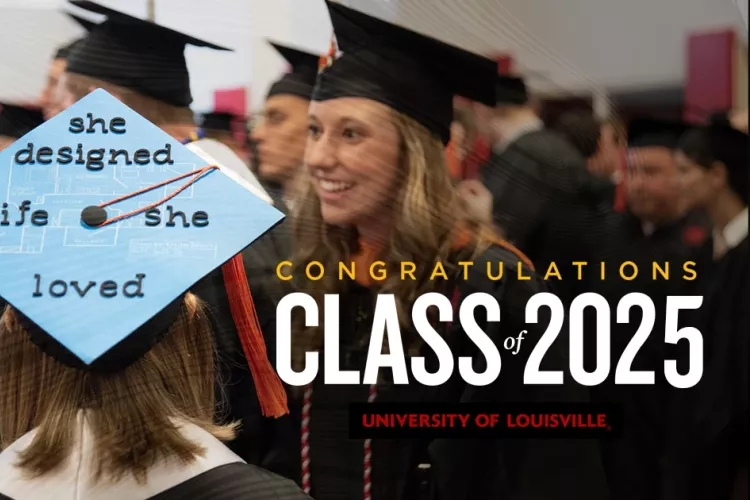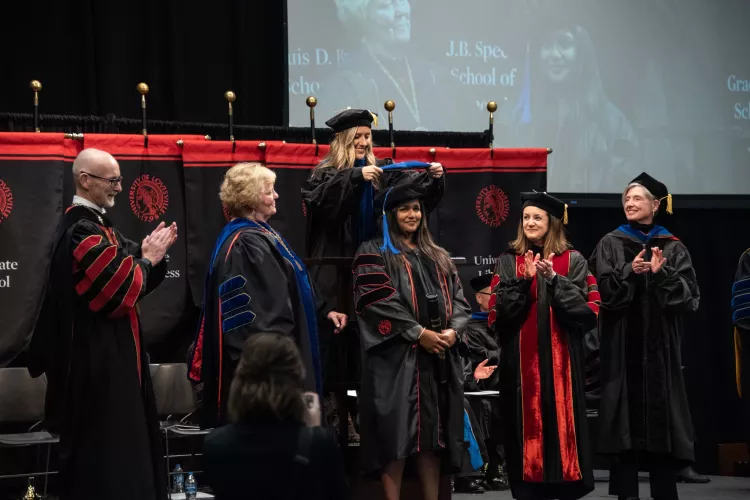Two retiring faculty members reflect on how they changed UofL's graphic design program
October 2, 2024If you put Steve Skaggs and Leslie Friesen in the same room, chances are they’ll tag team entire conversations with enthusiasm, finishing each other’s sentences and frequently lobbing compliments back and forth.
This was the case recently when the two gathered in the “red chair room” in the basement of Schneider Hall to talk about UofL’s graphic design program. They talked about what defines a visual object and semiotics and other granularities unfamiliar to those not actually in the world of graphic design.
They also talked about the history of the program – its ups and downs – and how each other’s strengths ushered the department into a modern era.
This friendly, thoughtful dialogue has been happening between them for over 20 years now, sometimes in the red chair room, sometimes over a cup of coffee at McDonald’s. But these conversations will soon become less frequent as both faculty members recently announced their retirement.
Professor Skaggs is the head of the graphic design BFA track. He earned his degree from UofL in 1973, then worked in design in Atlanta before heading off to grad school at the Pratt Institute in New York. He then spent three years as an assistant professor at the University of Kansas before taking over the UofL program in 1983.
Skaggs followed a pretty deep bench. In fact, the first graphic design professor hired at UofL was Malcolm Grear in 1950 (if that name sounds familiar, it’s because Grear designed the look for the 1996 Olympics in Atlanta). Grear was followed by Robert Doherty, under whom Skaggs studied, and Daniel Boyarski.
By the time Skaggs took over, he immediately identified changes he wanted to make and was able to conceptualize how he wanted the program to grow.
“There weren’t a lot of changes made to the curriculum before then and graphic design was boxed together with media,” he said. "It wasn't meant to be a graphic design program but rather a design thinking series of courses."
Skaggs spent years scribbling down his ideas and was finally able to articulate them to then-President John Shumaker. He wrote his first vision statement in 1984.
“I didn’t think our students were fully prepared and I wanted to guide them to do more than just think and figure life out on their own,” Skaggs said. “I knew if we were going to do this right, the minimum we needed was curriculum that required either four or five adjuncts or a second full-time person.”
The vision statement finally becomes a reality
His vision, however, didn't become a reality until nearly 18 years later. Enter Friesen, who joined the department in 2002 as the Power Agency Designer-in-Residence. Skaggs calls her hire the “big turning point of the program.”
Friesen, also a UofL graduate, said her role was specifically focused on three objectives – teaching, facilitating internships and serving as a professional liaison. That latter directive was the catalyst for Portfolio Day, an annual event for graduating students to showcase their design portfolios to local and regional professionals.
“The first Portfolio Day was in 2003. Suddenly it’s a big event now, with agencies and professionals coming from all over. Now people are coming to us and they’re hiring our students,” Friesen said.
Indeed, Portfolio Day has heightened the profile of the program. According to Skaggs, it also enables our students to better connect with the city.
“Louisville is a vibrant city. I felt that we needed to put more horsepower into that piece and Leslie has done just that with Portfolio Day,” he said.
Together, Skaggs and Friesen have also shifted the program’s curriculum to better suit individual students’ development and specialized areas. These changes are necessary to keep pace with the industry at large.
“As a result, our students are better able to compete against huge art school programs that have four times as many design courses we have. We’re able to punch above our weight and our students are more prepared because we’re now able to customize the program to them,” Skaggs said.
Where the program goes from here
Notably, Skaggs’ vision statement expanded beyond just two full-time faculty and, for a brief moment, there were three professors bouncing ideas off of each other and complementing each other’s strengths. Meena Khalili was brought on board in 2016, however, moved in December 2019 just before Covid-19 grinded any potential for a replacement to a halt.
Skaggs would like to get back to at least three full-time faculty members to keep the program moving forward. For now, however, with Skaggs and Friesen phasing into retirement, the department has brought on Trysh Wahlig, assistant professor in graphic design and program head, and Sheri Squires, designer-in-residence. They’ve got the chops, as Skaggs says. Wahlig is a graduate of the prestigious Illinois Institute of Technology and was most recently employed by Humana.
Squires has been an adjunct for several years and is a graduate of the University of Cincinnati’s Design, Art, Architecture and Planning program. She has publication and agency experience and has served as president of the Louisville Graphic Design Association.
Although Skaggs will stay on another year to help them transition, and Friesen may be called up to adjunct, both are full of retirement-induced reflection on how their work has made an impact for their students, for the department, for UofL and for the city.
Friesen effortlessly ticks off an extensive list of alums from the program who have gone on to accomplish big things, for instance, working for companies like PepsiCo, LinkedIn and the University of Chicago Press.
“I could go on and on and on. I take great pride in our students. They have proven they can really go far,” she said.
Skaggs admits he’s not necessarily an excitable person, but that changes on a dime when he talks about his students, particularly their ambitions and ideas.
“It’s not enough for students just to be making something pretty. What gets me charged about the program is to have students with a dream and try to make it and to have those dreams be realistic – they can make it successfully as a designer,” he said. “Ideas is the other part. The world of design is about ideas and that exchange of ideas between students and faculty excites me.”
No doubt that exchange of ideas will continue between the students, Wahlig and Squires. Asked what else he’d like to see from the program after his retirement, Skaggs simply says “it’s not my call anymore. The program is in good hands.”
That’s not to say he doesn’t take pride in where the program is now, all thanks to his vision scribbled on a piece of paper in the 1980s and a strong working relationship with someone who shared that vision.
“If this program is an animal, it was in kind of a nymph stage for a generation and then it suddenly became a butterfly,” he said. “Once it became a butterfly, it wasn’t the biggest butterfly. But it was a really beautiful butterfly.”



